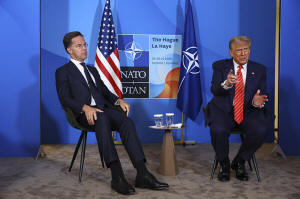Back to the future: NATO leaders hark back to the Cold War as they meet
to hike defense spending
[June 25, 2025]
By MIKE CORDER, SYLVIE CORBET, MOLLY QUELL and LORNE COOK
THE HAGUE, Netherlands (AP) — NATO Secretary-General Mark Rutte was
upbeat that the military organization will agree on massive spending
hikes at a “transformational summit” on Wednesday, as member state
leaders including U.S. President Donald Trump assembled in the
Netherlands.
Leaders of the 32-nation alliance are expected to agree a new defense
spending target of 5% of gross domestic product, as the United States —
NATO’s biggest-spending member — shifts its attention away from Europe
to focus on security priorities elsewhere.
“So a transformational summit. Looking forward to it,” Rutte told
reporters in The Hague, before chairing the meeting’s only working
session, which was expected to last less than three hours.
But ahead of the meeting, Spain announced that it would not be able to
reach the target by the new 2035 deadline, calling it “unreasonable.”
Belgium signaled that it would not get there either, and Slovakia said
it reserves the right to decide its own defense spending.
Many European countries face major economic challenges, and Trump’s
global tariff war could make it even harder for America’s allies to
reach their targets. Some countries are already squeezing welfare and
foreign aid spending to channel extra funds into their military budgets.
On Tuesday, Trump complained that “there’s a problem with Spain. Spain
is not agreeing, which is very unfair to the rest of them, frankly.” He
has also criticized Canada “a low payer.” In 2018, a NATO summit during
Trump’s first term unraveled due to a dispute over defense spending.

But Rutte conceded that “these are difficult decisions. Let’s be honest.
I mean, politicians have to make choices in scarcity. And this is not
easy.” But he said: “given the threat from the Russians, given the
international security situation, there is no alternative.”
Russia's neighbors lead the pack in boosting spending
Other countries closer to the borders of Russia and Ukraine — Poland,
the three Baltic states and Nordic countries — have committed to the
goal, as have NATO's European heavyweights Britain, France, Germany and
the Netherlands.
“This is a big win, I think, for both President Trump and I think it’s
also a big win for Europe,” Finnish President Alexander Stubb told
reporters. “We’re witnessing the birth of a new NATO, which means a more
balanced NATO.”
He said it would take nations “back to the defense expenditure levels of
the Cold War.” NATO countries started to cut their military budgets in
safer times after the Berlin Wall collapsed in 1989.
In a fresh take on Trump’s MAGA movement, Lithuanian President Gitanas
Nausėda said: “We should choose a motto, ‘make NATO great again.’”
[to top of second column]
|

President Donald Trump, right, speaks during a meeting with NATO
Secretary General Mark Rutte as he arrives for a NATO summit in The
Hague, Netherlands, Wednesday, June 25, 2025. (Piroschka van de Wouw,
Pool Photo via AP)

After Russia’s full-scale invasion of Ukraine in 2022, the NATO
allies agreed to make 2% of GDP the minimum spending level. Last
year, 22 countries were expected to hit that target, up from just
three a decade ago.
In The Hague, the allies plan a major revamp of their spending
targets. They are expected to up the ante for what NATO calls “core
defense spending” to 3.5%, while changing how it's counted to
include providing military support to Ukraine.
To hit Trump's 5% demand, the deal will set a second target of 1.5%
of GDP for a broader range of defense-related spending, such as
improving roads, bridges, ports and airfields so that armies can
deploy more quickly, countering cyber and hybrid attack measures, or
preparing societies to deal with future conflicts.
Progress will be reviewed in 2029, after the next U.S. presidential
elections.
“This declaration is historic. We are 32 allies supporting that
ambition, which is huge,” said Norwegian Prime Minister Jonas Gahr
Støre. “We have been struggling to get above 2% and now we said
3.5%, which is necessary in order to reach our capabilities.”
Earlier this month, NATO agreed individual purchasing targets for
nations to stock up on weapons and military equipment to better
defend Europe, the Arctic and the North Atlantic, as part of the
U.S. push to ramp up security spending.
US decision on forces in Europe expected in coming months
Extra funds will also be needed should the Trump administration
announce a draw-down of forces in Europe, where around 84,000 U.S.
troops are based, leaving European allies to plug any security gaps.
The Pentagon is expected to announce its intentions in coming
months.
Beyond Trump's demands, European allies and Canada have steeply
ramped up defense spending out of concern about the threated posed
by Russia. Several countries are concerned that Russia could carry
out an attack on NATO territory by the end of the decade. Hungary is
not one of them, though.
“I think Russia is not strong enough to represent a real threat to
us. We are far stronger,” said Hungarian Prime Minister Viktor Orbán,
fielding questions from reporters, leaning back with his hands
thrust into his pockets. Orbán is considered Russian President
Vladimir Putin's closest ally in Europe.
All contents © copyright 2025 Associated Press. All rights reserved
 |